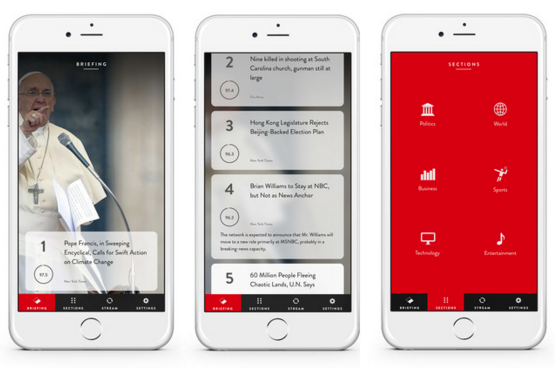This past Monday I presented to my Mobile and Social Media Journalism class about a new-ish mobile app on the market: BriefMe.

This is what the BriefMe app icon looks like in the Apple Store.
The app, released on the Apple Store in March 2015, presented a new algorithm to how news would be organized and presented to its users.
It was a trio of Harvard and Yale students who created the app just a few years ago, and have since worked together in the Harvard Innovation Lab to build the app to idea to a functioning prototype to a tangible product available to the public.
How does it work?
The purpose of this app is to provide users with the most relevant, updated news from multiple sources all aggregated onto one platform. The news is arranged based on its “virality” score, a number compiled based on how popular the article is on the Internet in real-time.

This is what the basic interface of the app would look like on an iPhone.
The top ten stories with the highest score, which ranges from 0 to 100, are then placed on the app’s home page interface complete with a little summary and the ability to read the complete article on the app, without having to go to another news site.
The virality score is also attached to each article, and if the user wishes to view it, all they need to do is click down and how the score was tallied is listed for their viewing pleasure.
What does this mean for the world of journalism?
We’ve been seeing the trend for a while of different articles, and even different news outlets, being more internet savvy.
With apps like BriefMe that run off of algorithms solely based on Internet popularity, users run the risk of only seeing the “click-baity” articles that are often thrown around and shared on social media sites. BriefMe, however, at least prevents the news users see on their phone from only being what their friends have shared.
One writer for TechCrunch believes that apps like BriefMe, and the social media trend in general, have given way to a “front-page” approach to news where editors no longer have the power to point audiences toward the best stories, but just the most relevant stories.
The writer also believes that this app follows social media in what he calls the “stability problem,” or the fact that on the Internet something is only going to “hot” for so long.
I believe that this app, like any other news source that the public uses, is never going to be a complete grasp of the news world. As it was once important to read more than one newspaper, it remains important to follow the news from more than one source or news-aggregation app.